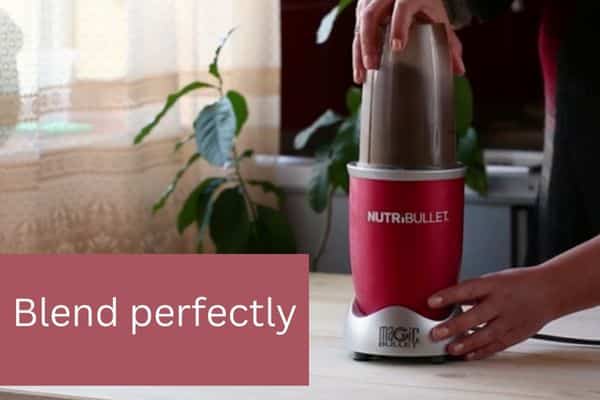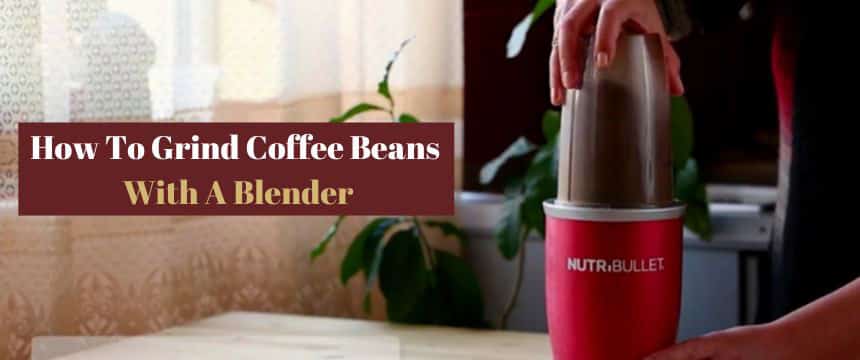Few people realize that a blender could be an excellent instrument for breaking down your favorite coffee beans. The result may not be as good as a coffee grinder, but when you only have a blender to work with this is a lifesaver. Here is a step-by-step guide on how to grind coffee beans with a blender.
If you want the short version, you will need at least 3 cups of coffee beans. Because of the blade height, it’s better to use as many beans as possible to submerge the blade completely. Then all that is left is to blend thoroughly until seeing consistency in the particle size. Finally, sieve out the finer ground coffee for espresso or coarser ground for a French press.
Table of Contents
Why do we need to grind coffee beans first?
Coffee beans contain all the nutrition and flavor profile. When you break the beans, all the particles will have more surface so hot water can seep in and extract all the goodies on the way to dripping. Then you will have a coffee with proper strength, color and flavor.
Better Flavor Extraction: The interesting thing is you can absolutely make a cup of coffee with whole beans. It just won't be a good one. You will lose most of the flavor as water can not get inside the beans properly. At this point, you should lower your expectations even if the beans you have are a special kind.
Fresh Brew: Compared to pre-ground Coffee, whole coffee beans start to deteriorate much more slowly after roasting. That’s one of the reasons coffee enthusiasts prefer whole beans. That way they can grind only the amount they need and enjoy fresh brew for days to come.
Minimize Wastage: To put into contrast, properly ground coffee results in a far better yield than pre-ground coffee. Naturally, you will add more coffee to balance your particular taste. That can add a huge amount of coffee wastage if you consume it regularly. So these are the fair reasons why coffee enthusiasts like to grind coffee beans rather than going for pre-ground coffee or even whole beans.
Grinding Coffee Beans With A Blender In 5 Steps
Grinding coffee beans in a blender isn’t something new that people are just finding out now. Some of us have been in a situation like in hotels or air BNBs where there is only a blender for use. Instinctively, you may have wondered “can I grind coffee beans in a blender?”. Well, you definitely can!
Step 1: Wash and dry the jar
Before you put any coffee beans in the blender pitcher, thoroughly wash the jar and pat it dry with a cloth. You can also hang dry if you have enough time to spare. The reason we have to clean the jar is because of the possible contamination.
Your blender may have residue from the last blending session and you don't want that in your coffee ground.
So clean it and prepare the jar for the next step of coffee grinding.
Step 2: Pour Coffee Beans
You should know that you cannot grind a few beans in a blender like a dedicated coffee grinder. The coffee grinder has a flat blade that is closer to the surface. This allows the blade to break a few coffee beans and still put a bite on the broken pieces of beans.
That's not the case with a blender. Blender usually comes with a cross blade and has quite an open surface around the blade.
So grinding a few beans would be more of a hit or miss and you will need more time to get to an acceptable consistency.
So the best practice would be to fill up to the edge of the blade or more to be safe.
As you grind the beans the overall level will decrease as the bean breaks down to fine particles.

Step 3: Blend perfectly
Now that you have poured the coffee beans, it’s time to blend until you like the particle size. Always start with the lowest speed to avoid jamming and splatter. After a couple of seconds, speed up the grinder to the highest speed available.
You will see the finer particles are settling down and the coarse particles are shifting upwards. That is a good sign that blender is working great.
A good tip to speed up the process would be to slightly shake the jar without detaching it from the blender itself. You can also tilt the whole blender slowly for the same effect.

Step 4: Separating
Once you have reached the point where you see the particles are close to unified size, you are ready to separate the finer grounds. Although this is an optional step to fine-tune the flavor, you can follow this step if you have a sieve.
Alternatively, you can also use a pour-over paper filter or a french press to make delicious coffee right from the jar. Again, you might taste some irregularity due to inconsistent coffee grounds but it’s much better from whole bean coffee.
Step 5: Brewing Coffee
Lastly, give it as much time as you can to perform a slow brew. With time coffee flavors develop complexities and flavor notes. So leave the cup on the table for a couple of minutes and enjoy your perfect cup of freshly ground coffee.
FAQs
How To Blend Coffee Beans in a Food Processor?
Unfortunately, blending coffee beans in a food processor isn't very practical as far as consistency goes. The wide blade formation of a food processor is ideal for chopping vegetables into rough pieces. If you put coffee beans in the food processor, it will leave you with much bigger fragments than the ideal size. Your coffee will be mild and close to tasteless. So it is not advisable to blend coffee beans with a food processor.
Can You Use A Blender To Grind Coffee For An Espresso?
For espresso, you will need the finest coffee ground for that dense and concentrated flavor. It is not impossible to make that kind of ground coffee from a blender. You just have to blend the coffee beans really well and use a sieve to separate the finest particles before making an espresso.
Can You Grind Coffee Beans By Hand?
There are ways you can break the coffee beans by hand so you can enjoy a flavorful coffee. But keep in mind that you need at least a hammer or a piece of solid wood to break them. You will also need a plastic zip bag so that when you smash them they won't fly off. The spice mortar also makes fine grind if you happen to have one lying around you.
How to Grind Coffee Beans at Home?
To grind coffee beans at home you must have any of these appliances such as a burr grinder, coffee grinder, blender with a grinding pitcher, and so on. If any of these are not in your reach, use a solid block to smash the beans in a plastic bag. Put effort to even out the particles as much as you can for a better taste.
Final Verdict
Hope you have learned a thing or two about how to grind coffee beans with a blender when you don't have access to a coffee grinder. Be sure to follow our steps and be patient with your first couple of tries. With such trial and error, you will find your optimum procedure and can make a great cup of coffee every time.
Related Blog:

